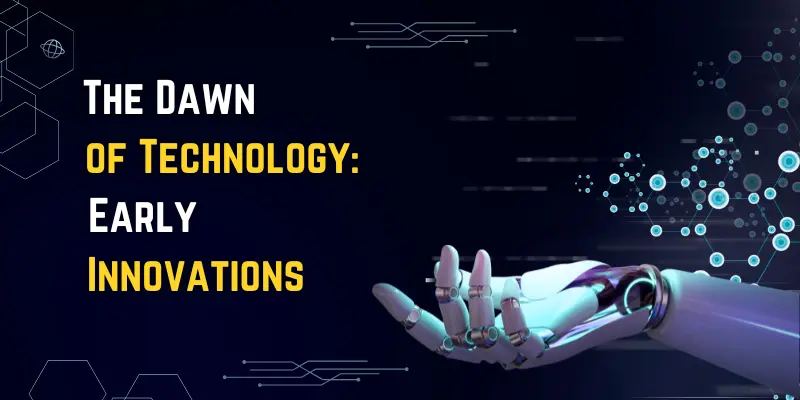History of Technology: How It Shaped Our World and Future
Published: 23 Jan 2025
Introduction
Have you ever wondered how the world went from simple stone tools to smartphones in your pocket? Technology has come a long way, shaping every aspect of our lives—from how we communicate to how we work, travel, and even entertain ourselves. But understanding the History of Technology isn’t just about looking back; it’s about appreciating the incredible journey that brought us to where we are today and where we might go next.
In this blog, we’ll take a fascinating trip through time. You’ll discover the origins of technology, explore key milestones like the invention of the wheel and the rise of the internet, and get a glimpse of how emerging innovations could shape our future. Ready to dive in? Let’s uncover the story of our progress, one invention at a time!
The Dawn of Technology: Early Innovations
Definition of Technology
Let’s keep it simple—technology is any tool, system, or method that we use to solve problems and make life easier. Whether it’s a sharpened stone to hunt animals or the latest smartphone to connect with friends, technology is all about innovation to meet our needs.

Early Human Tools: A Peek Into the Past
The story of technology starts with the simplest tools that helped us to survive and thrive.
Stone Tools
- Early humans used stones to hunt animals, chop wood, and farm.
- These tools were sharp and simple but made survival easier.
- Example: Flint stones were used to make spears and axes.
Fire: The Game-Changer
- Fire was a turning point in our history.
- It provided warmth, protection from predators, and a way to cook food.
- Example: Cooking with fire made food safer and tastier, improving health.
The Wheel: Revolutionizing Transport
- The invention of the wheel transformed how goods and people moved.
- It made farming, trade, and travel faster and easier.
- Example: Early wooden wheels were used in carts for farming and carrying loads.
Real-Life Examples
- Fire for Survival: Imagine sitting by a fire, safe from wild animals at night, while cooking a freshly hunted meal. That’s how early we lived!
- Stone Tools for Farming: Tools like hand axes and sickles helped in cutting crops and clearing land, paving the way for agriculture.
These simple innovations might seem basic now, but they laid the foundation for the complex technology we use today!
Major Technological Revolutions
Each technological revolution has transformed how we live, work, and connect with the world. Let’s explore the key revolutions that shaped our history.
A. Agricultural Revolution
The Agricultural Revolution marked the shift from hunting and gathering to farming. This period laid the foundation for settled communities and the growth of civilizations.
Transition from Hunting to Farming
- We moved from nomadic lifestyles to settled agricultural communities.
- Farming allowed for a stable food supply and population growth.
Invention of Irrigation and Farming Equipment
- Early irrigation systems made it possible to water crops efficiently.
- Tools like sickles, plows, and hoes made farming more productive.
Example: The Plow’s Impact on Food Production
- The plow, pulled by animals, revolutionized agriculture by preparing soil faster.
- It increased crop yields and supported larger populations.
B. Industrial Revolution
The Industrial Revolution introduced machines and factories, replacing manual labor with mass production. It reshaped industries and urban life.
Shift from Manual Labor to Machines
- Machines made manufacturing faster and cheaper.
- This shift led to the rise of industrial cities and factory work.
Steam Engines, Factories, and Mass Production
- Steam engines powered trains, ships, and machines, enabling global trade.
- Factories mass-produced goods like textiles, making them more affordable.
Example: The Cotton Gin’s Impact
- The cotton gin, invented by Eli Whitney, sped up the separation of cotton seeds from fibers.
- It boosted the textile industry and revolutionized clothing production.
C. Digital Revolution
The Digital Revolution is ongoing and continues to reshape how we live and work. It started with the rise of computers and the internet.
Introduction of Computers and the Internet
- Computers automated tasks and solved complex problems quickly.
- The internet connected people globally, enabling instant information sharing.
How Digital Tools Reshaped Society
- Communication: From letters to instant messaging and video calls.
- Education: Online learning platforms provide access to knowledge anywhere.
- Entertainment: Streaming services transformed how we watch movies and listen to music.
Example: Pre-Internet vs. Today
- Before the internet, people relied on letters and telegraphs to communicate.
- Today, emails, messaging apps, and social media have made communication instantaneous.
Key Milestones in Technology
Throughout history, several groundbreaking inventions have transformed how we live and interact with the world. Let’s explore some of the most important technological milestones that shaped modern civilization.
The Printing Press (1440s)
The printing press was a revolutionary invention that made books and information accessible to more people.
Revolutionized the Spread of Knowledge
- Before the printing press, books were copied by hand, making them expensive and rare.
- The printing press allowed for mass production of books at a lower cost.
- It helped spread ideas, science, and education faster than ever before.
Example: Gutenberg’s Printing Press and Its Impact on Literacy
- Johannes Gutenberg invented the first movable-type printing press in the 1440s.
- It made books like the Bible widely available, increasing literacy rates across Europe.
- The press played a major role in the Renaissance and the spread of knowledge globally.
Electricity (1800s)
Electricity transformed the way people lived, worked, and connected with the world. It became a key part of homes, businesses, and industries.
Powering Homes and Industries
- Electricity replaced candles and gas lamps, making homes brighter and safer.
- Factories used electric machines to produce goods faster and more efficiently.
- It led to the invention of various household appliances, improving daily life.
Example: Thomas Edison and the Invention of the Light Bulb
- Thomas Edison invented the practical incandescent light bulb in 1879.
- It allowed people to work and live beyond daylight hours.
- The invention of power grids brought electricity to millions of homes and businesses.
The Internet (1960s-Present)
The internet revolutionized communication and information access, making the world more connected than ever before.
Global Connectivity and Information Access
- The internet allows instant communication across the world.
- It provides access to information, education, and entertainment with just a click.
- Businesses, governments, and individuals rely on the internet for daily tasks.
Example: How Websites Like Google Transformed Knowledge Sharing
- Before the internet, people used libraries and newspapers to find information.
- Google made it easy to search for anything in seconds, changing how we learn and work.
- Social media and online platforms have further connected people globally.
How Technology Shapes Everyday Life
Technology has become an essential part of our daily routines, changing the way we travel, stay healthy, and connect with others. Let’s explore how different aspects of life have evolved with technological advancements.

Transportation: Moving Faster and Smarter
From slow, manual methods to fast and efficient travel, technology has revolutionized transportation.
From Horse-Drawn Carriages to Electric Cars
- In the past, people relied on horses and carts for travel, which was slow and tiring.
- Today, electric cars offer a faster, cleaner, and more efficient way to travel.
- Modern transportation options reduce pollution and are more convenient.
Example: Trains in the 1800s vs. Modern High-Speed Rail
- In the 1800s, steam-powered trains were the fastest way to travel long distances.
- Today, high-speed trains can travel hundreds of miles per hour, connecting cities in record time.
- Bullet trains use advanced technology to offer a smooth, fast, and eco-friendly ride.
Medicine: Saving Lives Through Innovation
Technology has greatly improved healthcare, making it possible to diagnose and treat diseases more effectively.
Advancements Like Vaccines, X-rays, and Robotic Surgeries
- Vaccines have helped prevent deadly diseases and save millions of lives.
- X-ray machines allow doctors to see inside the body without surgery.
- Robotic surgeries offer precision and faster recovery for patients.
Example: Life Expectancy Improvements Due to Medical Breakthroughs
- In the past, common illnesses like infections were often fatal.
- Thanks to vaccines, antibiotics, and modern treatments, people now live much longer.
- Diseases that once had no cure can now be treated with advanced medical technology.
Communication: Staying Connected Anytime, Anywhere
Technology has transformed the way we interact with others, making communication faster and easier.
From Telegrams to Smartphones
- Telegrams were used to send short messages over long distances, but they were slow and expensive.
- Today, smartphones allow instant communication through calls, texts, and social media.
- With a smartphone, people can stay connected with family, friends, and colleagues from anywhere in the world.
Example: The Impact of Video Calls During the Pandemic
- During the COVID-19 pandemic, video calls helped people stay in touch with loved ones despite lockdowns.
- Businesses used virtual meetings to continue operations without physical presence.
- Online education and remote work became possible thanks to communication technology.
Conclusion
So guys, in this article, we’ve covered the History of Technology in detail. It’s amazing to see how we’ve gone from simple stone tools to the smart gadgets we use today. Technology has truly transformed the way we live, work, and connect with each other. My personal thought?
Stay curious and keep exploring new innovations—you never know what exciting advancements are just around the corner! If you enjoyed this journey through time, share this article with your friends and let us know which technological milestone you find the most fascinating in the comments below!
Common FAQs on the History of Technology
Technology is anything we create to make life easier, like tools, machines, and systems that help us solve problems and do things faster.
Technology wasn’t invented by one person. Early humans started using simple tools like stones and fire, and over time, people invented more advanced things.
The earliest known technology includes stone tools, which were used by early humans to hunt and build things. Fire was also a major discovery.
Technology has grown from basic tools to advanced machines, like computers and smartphones. It keeps improving to make life more convenient.
Some of the biggest inventions include the wheel, the printing press, electricity, the telephone, and the internet.
It helps us with everything—communication, travel, work, entertainment, and even health care. It makes things faster, easier, and more fun.
The internet connects people across the world, gives access to unlimited information, and makes communication instant and easy.
Electricity powers almost everything we use today, from lights and appliances to computers and transportation systems.
Bonus Points
- Technology connects us like never before. It helps us stay in touch with friends and family, no matter where they are in the world.
- Old inventions still matter today. The wheel, fire, and even early farming tools are still part of our daily lives in one way or another.
- Learning is easier thanks to technology. From online courses to educational apps, gaining knowledge has never been this simple and fun.
- Technology makes life more comfortable. From smart home devices to electric cars, our lives are getting easier and more efficient every day.
- Entertainment has changed completely. We’ve gone from radios and black-and-white TVs to streaming movies and music instantly on our phones.
- Healthcare has improved a lot. Thanks to technology, doctors can now diagnose and treat diseases better and faster than ever before.
- The way we work has evolved. Remote work, online meetings, and smart tools have changed how businesses operate and people work.
- Technology keeps things safe. Security systems, smart locks, and surveillance cameras help protect our homes and offices.
- Traveling has become faster and easier. From horses to cars, planes, and even space exploration, getting around has never been so quick.
- The future holds endless possibilities. With AI, robotics, and space exploration, we’re just getting started with what’s possible in technology.

- Be Respectful
- Stay Relevant
- Stay Positive
- True Feedback
- Encourage Discussion
- Avoid Spamming
- No Fake News
- Don't Copy-Paste
- No Personal Attacks

- Be Respectful
- Stay Relevant
- Stay Positive
- True Feedback
- Encourage Discussion
- Avoid Spamming
- No Fake News
- Don't Copy-Paste
- No Personal Attacks



